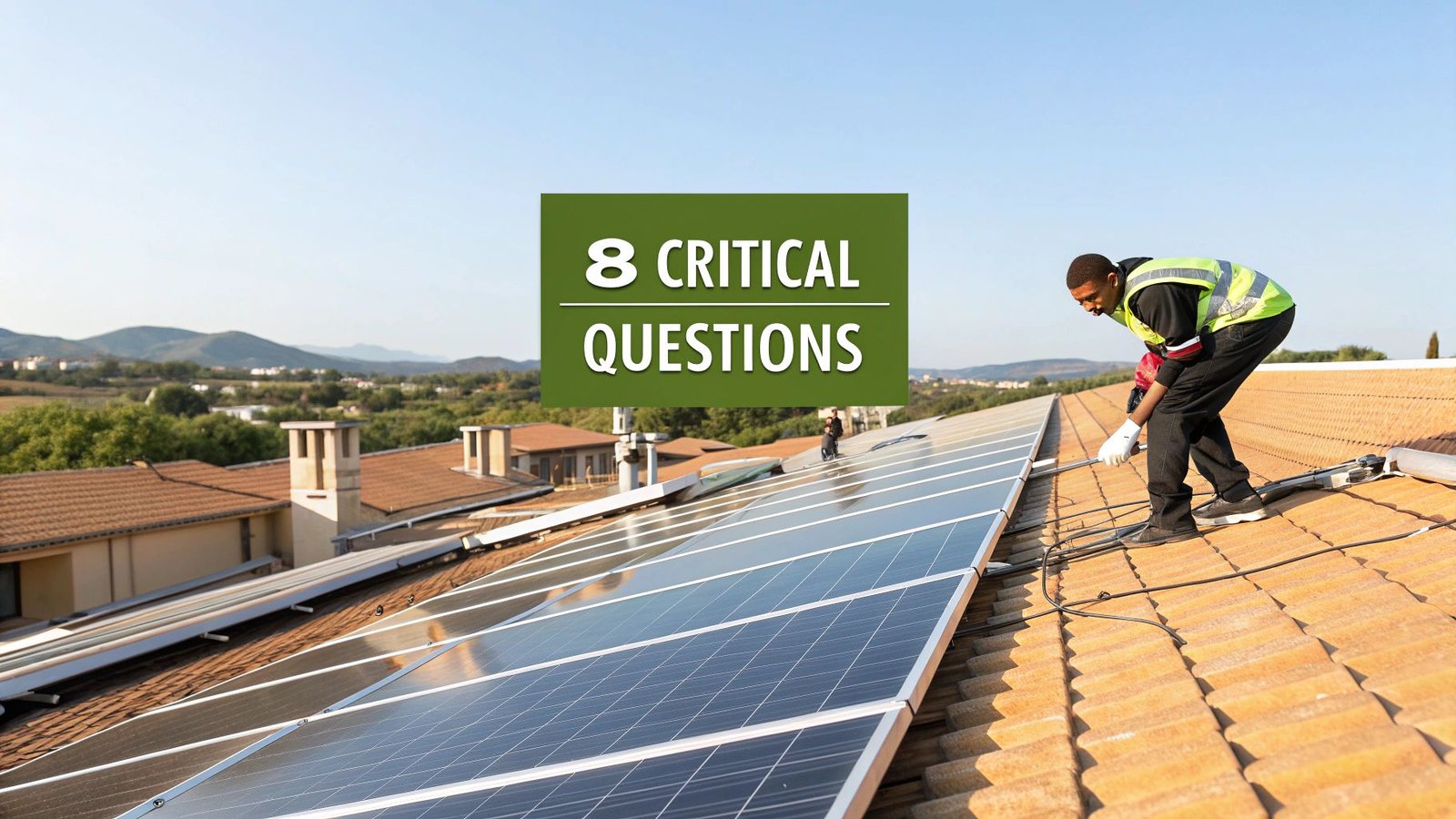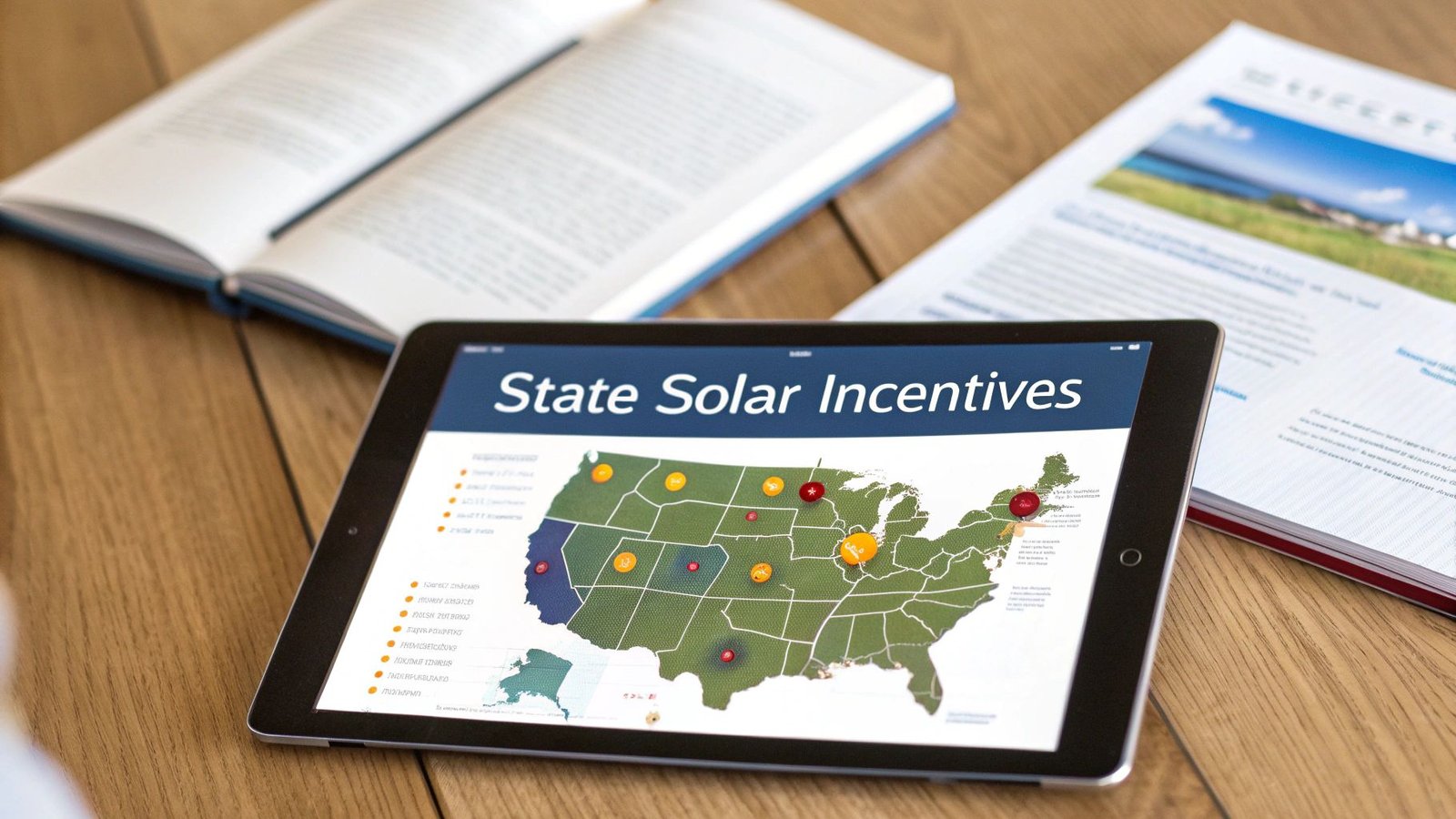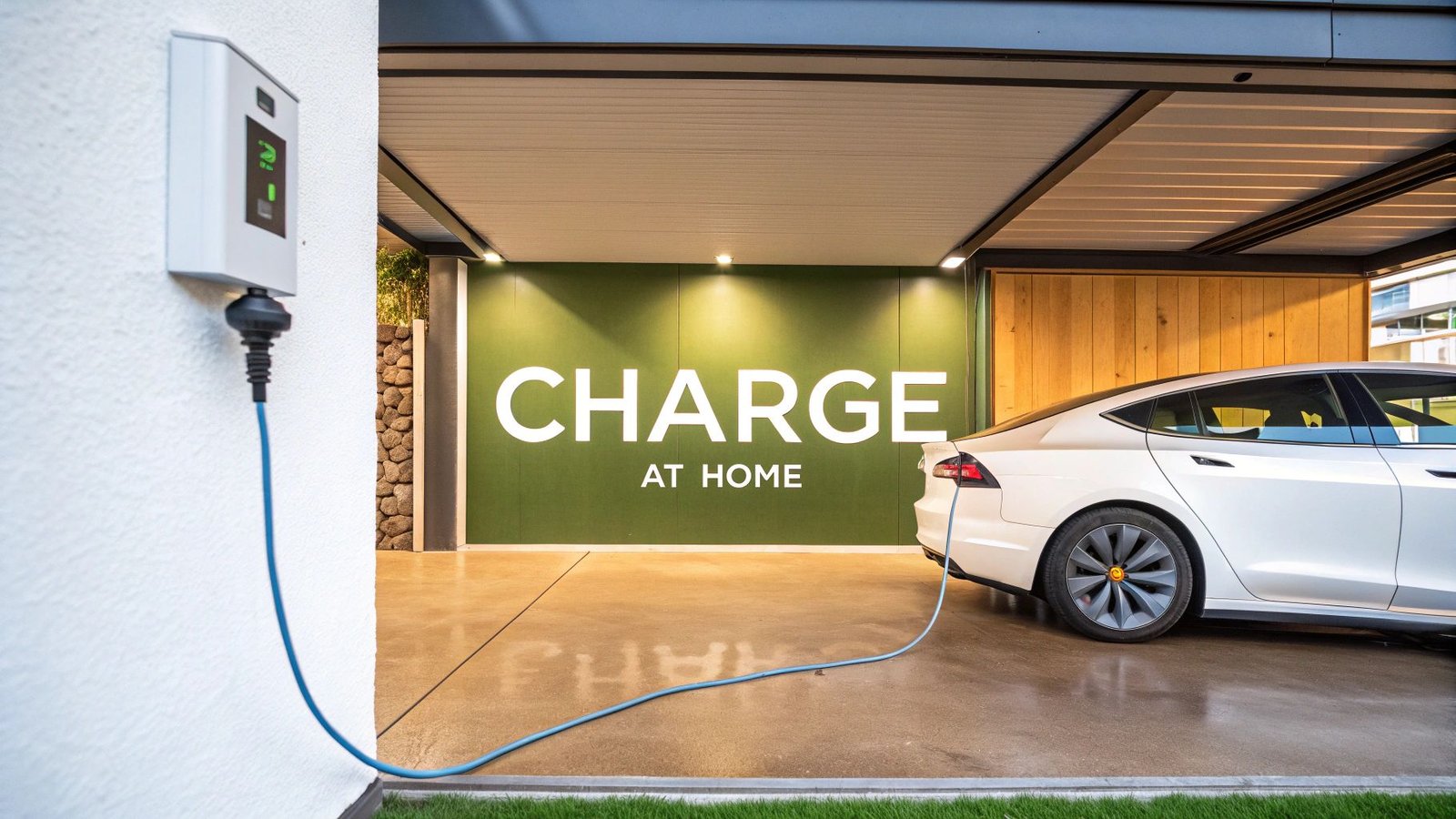Before you even think about installing solar panels, you have to look at the foundation they’ll be sitting on for the next 25 o 30 years: your roof. A solid, well-maintained roof isn't just a suggestion; it's an absolute must for a safe and worthwhile solar investment.
Is Your Roof Solar-Ready?
Imagine your roof as the launchpad for a long-term energy mission. That launchpad needs to be in prime condition before you can even think about harnessing the sun's power. The success of any residential solar panel installation hinges completely on the health and suitability of the roof it rests on.
A proper assessment is more than just a quick glance from the street. It’s a deep dive into several interconnected factors that determine if your home is truly ready for a solar energy system. Skipping this step can lead to expensive repairs, poor energy production, and even serious structural damage down the road.
The Five Pillars of Solar Readiness
To get a quick read on your home's potential, we can break it down into five critical areas. Each one is essential for ensuring your solar energy system is safe, efficient, and built to last.
- Structural Strength: Your roof has to be strong enough to handle the extra weight of solar panels and their mounting hardware. This typically adds about 3-4 pounds per square foot, and the structure must be able to support that load without issue.
- Roof Age and Material: Solar panels are designed to last for decades. Your roof should be, too. Ideally, your roofing material should have at least 10-15 years of life left in it. You don't want to pay to remove and reinstall your entire solar array just to replace some shingles a few years later.
- Sun Exposure (Solar Access): For solar panels to do their job, they need sun—and lots of it. Your roof needs to get plenty of direct sunlight, without major shading from trees, chimneys, or neighboring buildings, to maximize energy production.
- Local Codes and Regulations: Every solar installation has to play by the local rules. This means complying with building, fire, and electrical codes that govern everything from panel placement to specific safety measures.
- Electrical System Compatibility: Your new solar system needs to connect to your home’s existing electrical grid. Your main electrical panel must have enough capacity to handle the new circuit safely and effectively.
To give you a clearer picture, here’s a quick checklist summarizing these five critical areas.
Quick Checklist for a Solar-Ready Roof
This table breaks down the five critical areas to assess before committing to a solar panel installation on your roof.
| Requirement Area | Key Consideration | Por qué es importante |
|---|---|---|
| Structural Integrity | Can the roof support an extra 3-4 lbs/sq ft? | Prevents structural damage, sagging, and ensures long-term safety. |
| Roof Age & Condition | Does the roof have 10-15 years of life left? | Avoids the high cost of removing panels for a future roof replacement. |
| Sun Exposure | Is the roof free from significant, day-long shade? | Maximizes energy production and the financial return on your investment. |
| Local Code Compliance | Does the plan meet all building, fire, and electrical codes? | Ensures the system is legal, safe, and will pass inspection. |
| Electrical Capacity | Can your main service panel handle the new solar circuit? | A necessary step for safely integrating the solar system with your home's grid. |
Thinking through each of these points is the best way to prepare for a smooth and successful installation.
A solar panel system is a long-term addition to your home. The roof underneath it should be viewed with the same long-term perspective. Investing in roof health first is the smartest financial decision you can make.
Before you go any further, it’s crucial to honestly evaluate your roof's current condition. It's worth looking for critical signs you need a new roof now to head off much bigger and more expensive problems later. Getting this right from the start is what sets you up for a great project.
Getting to Grips with Your Roof’s Structural Needs
Before a single solar panel makes its way to your rooftop, a serious engineering check-up has to happen. It's best to think of your roof's structure like a car's chassis—it was built to handle a specific amount of weight and stress. A solar panel system introduces a constant, permanent weight, what engineers call a dead load, that typically adds about 3 to 4 pounds per square foot.
Your home's roof needs the muscle to carry this extra weight for the entire Vida útil de 25 a 30 años of the solar system. This isn't just a suggestion; it's a fundamental requirement for a safe solar installation. A professional evaluation is the only way to be sure your home will stay structurally sound for the decades ahead.
Dead Loads vs. Live Loads: What’s the Difference?
When engineers look at your roof, they aren't just thinking about the static weight of the panels. They're running a complete load calculation that balances two critical forces:
- Dead Loads: This is all the constant weight your roof supports. It includes the roofing materials themselves, the framing, and of course, the new solar panels and all their mounting gear.
- Live Loads: This is where things get unpredictable. Live loads are the temporary, changing forces your roof has to endure. The biggest culprits are heavy snow piling up in winter and powerful winds trying to lift the roof up.
The structural engineer’s mission is to confirm that your roof’s total load capacity can handle both the dead and live loads at the same time without breaking a sweat. They dig into the details of your current structure to make sure it's up to the task.
This structural assessment isn't just about ticking a box. It's a critical safety measure that confirms your roof can handle the combined force of the solar panels y the most extreme weather your area can throw at it, whether that's a blizzard or hurricane-force winds.
The incredible boom in solar energy worldwide has pushed local authorities to get more specific about these requirements to ensure every installation is both safe and efficient. Most building codes now specify that roofs must support solar module weights ranging from 15 to 20 kg per square meter (which is about 3 to 4 lbs/sq ft). This standard provides a solid baseline for structural integrity, no matter the climate. You can get a better sense of the global solar trend by reading more about the rise of global solar installations.
What Inspectors Are Looking For in Your Attic
During a structural inspection, a professional is going to get up close and personal with the bones of your roof. They're on the hunt for any sign of weakness, damage, or wear and tear that could cause problems down the line.
This deep dive usually involves checking:
- Rafters and Trusses: These are the main support beams of your roof. The inspector will check their size, how far apart they are, and their overall condition, looking for any cracks, rot, or past modifications that might have weakened them.
- Roof Decking: This is the sheet of wood (usually plywood or OSB) that lies on top of the rafters. They'll check it for any water damage, soft spots, or sagging. The mounting hardware needs a solid deck to anchor into securely.
- Support Beams and Connections: Every point where framing pieces connect is examined to make sure it's solid. The inspection also considers the load-bearing walls and foundation to ensure the entire house can comfortably distribute the new weight.
If you have an older home with a frame that’s a bit undersized or showing its age, the engineer might call for some reinforcements. This isn't a deal-breaker. It could be as simple as sistering a few joists or adding a support column to get your home perfectly prepped for its solar power upgrade.
Choosing the Right Roofing Material
Beyond the sheer strength of your roof's structure, the material on top and its age are huge factors in the solar equation. Think about it: a solar panel system is a 25 to 30-year commitment. Your roof has to be a dependable partner for that entire journey.
There's nothing worse than having to tear down a perfectly good solar array just a few years in because your old shingles are failing. It's a costly, frustrating, and completely avoidable problem. This leads to what we in the industry call the 15-year rule.
Simply put, if your roof has less than 15 years of life left in it, you should almost always replace it antes de the panels go up. This syncs up the lifespans of your roof and your solar system, letting them work together seamlessly for decades to come.
gantt
title Synchronizing Roof and Solar Panel Lifespans
dateFormat YYYY
axisFormat %Y
section Solar Panels
Solar System Lifespan : 2024, 25y
section Old Roof (Needs Replacement)
Remaining Roof Life : 2024, 5y
Costly Panel Removal & Reinstall : 2029, 1y
New Roof Installation : 2029, 1y
section New Roof (Installed Before Solar)
New Roof Lifespan : 2024, 25y
This chart illustrates the financial benefit of replacing an old roof before a solar installation, aligning the lifespans and avoiding future removal costs.
Material Compatibility and How Panels Are Attached
Different roofing materials call for different solar installation game plans. The way we mount the panels is directly linked to the surface we're working with, which affects everything from the cost of the job to how complex it is.
- Tejas de asfalto: This is the most common roof in the country, so installers have this down to a science. We use special flashing mounts that slide right under the shingles, creating a watertight seal. It's a reliable and budget-friendly approach.
- Standing-Seam Metal: Honestly, this is the dream scenario for solar. The raised seams are the perfect anchor point for clamps that don't even penetrate the roof. No holes, no fuss. It keeps the roof’s warranty intact and makes the installation a breeze.
- Clay or Concrete Tiles: These require a more delicate touch. Tiles are brittle and can easily crack, so installers have to carefully remove a tile, attach a mount to the roof deck below, and then cut and flash the tile to fit perfectly around it. It’s more labor-intensive but ensures a secure, weatherproof fit.
- Flat Roofs (TPO, EPDM): You see these on a lot of modern homes and commercial buildings. Here, we typically use a ballasted system. Instead of drilling, the panels sit on a rack held in place by heavy concrete blocks. This protects the roof membrane, and we can easily tilt the panels to the perfect angle for sun exposure.
No matter the method, the goal is always the same: anchor the solar array securely to the roof's frame and make sure every single penetration point is sealed tight against wind and rain for the life of the system.
Comparing Your Roofing Options
The type of roof you have directly influences how easy the installation will be and how well your system performs over the long haul. Some materials are just naturally a better fit for solar, either because they're incredibly durable or they play nicely with standard mounting gear.
This chart shows just how much roof pitch can affect your solar panel efficiency, comparing the energy output for panels at three different angles.

As you can see, a moderate pitch of 30 grados hits the sweet spot, achieving the highest efficiency at 85%. Getting this right, along with choosing a durable material that's in great shape, is one of the most fundamental solar panel roof requirements for a successful project.
How Sun Exposure Impacts Your Energy Production
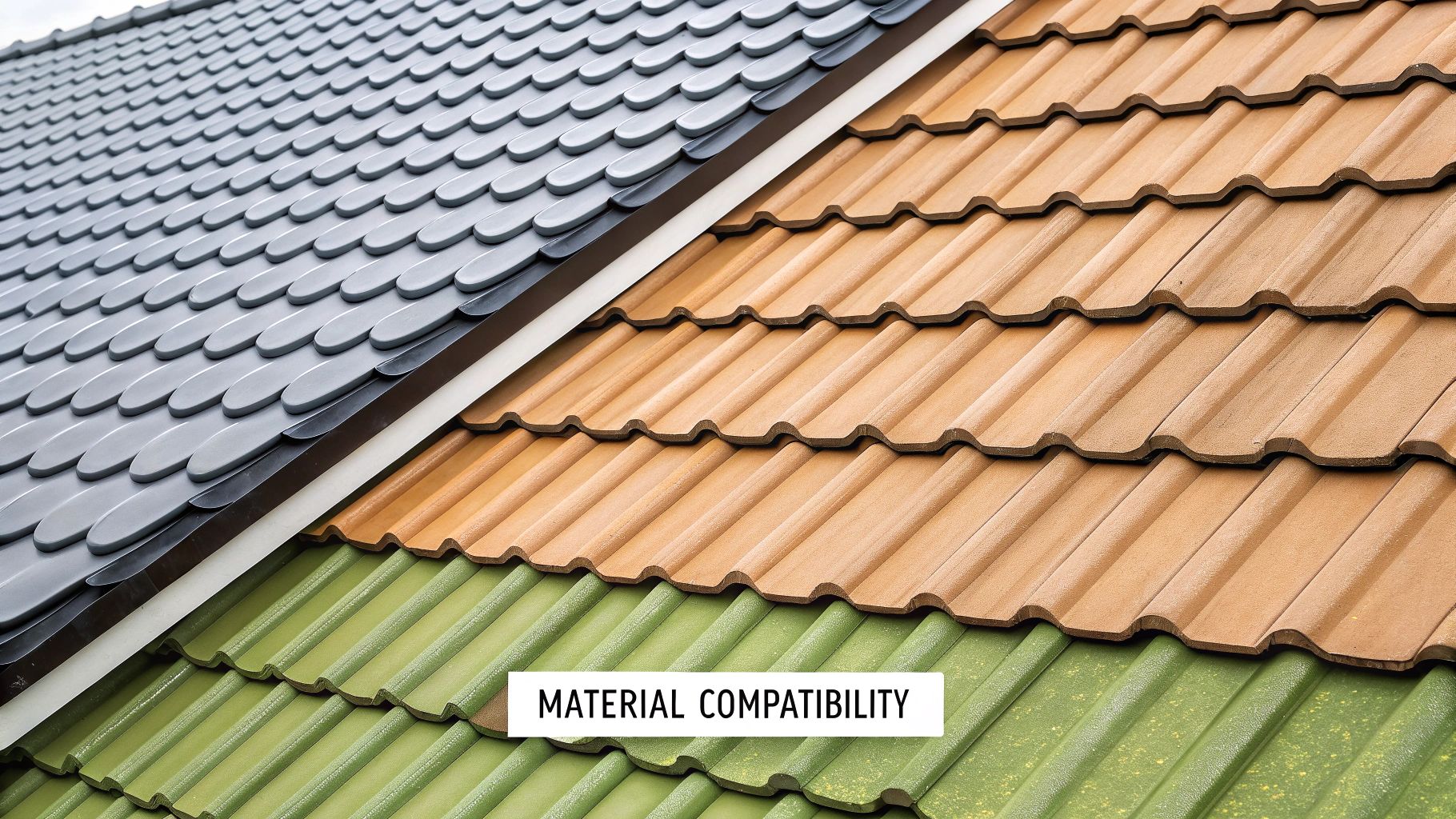
Having a solid roof is step one. But even the sturdiest roof won't do you any good if it's stuck in the shade. The second, and equally important, part of the equation is clear, direct access to sunlight. Solar panels are a bit like sunflowers; they thrive when they can soak up the sun's rays all day long.
To figure out your home's true solar potential, we have to look at three things: orientation (which way your roof faces), its pitch (the steepness), and any shading that might get in the way. Getting a handle on these factors is fundamental to designing a system that actually delivers on its promises.
The Best Direction for Solar Panels
For anyone living in the Northern Hemisphere, the absolute sweet spot for solar panels is a roof that faces true south. This gives the panels the most direct sunlight right through the middle of the day, especially during those prime sun hours between 10 a.m. and 3 p.m. This is how you squeeze every last drop of energy out of your system.
But here’s the good news: a perfect south-facing roof is nice, but it’s definitely not a deal-breaker. East and west-facing roofs are also fantastic candidates for solar.
- East-facing panels are early risers. They churn out the most power in the morning, which is a huge plus for households with high energy use at the start of the day.
- West-facing panels come alive in the afternoon and early evening. This timing is perfect, as it often lines up with when families get home from work and school, and energy demand skyrockets.
xychart-beta
title "Typical Energy Production by Roof Direction"
x-axis [6, 7, 8, 9, 10, 11, 12, 13, 14, 15, 16, 17, 18, 19, 20]
y-axis "Production (%)" 0 --> 100
line "South" stroke="blue" fill="lightblue" [0, 10, 30, 60, 80, 95, 100, 95, 80, 60, 30, 10, 5, 0, 0]
line "East" stroke="orange" fill="lightyellow" [20, 40, 70, 85, 90, 80, 60, 40, 20, 10, 5, 0, 0, 0, 0]
line "West" stroke="green" fill="lightgreen" [0, 0, 0, 5, 10, 20, 40, 60, 80, 90, 85, 70, 40, 20, 0]
bar "Peak Grid Demand" fill="#ffcccb" [0, 0, 0, 0, 0, 0, 0, 0, 0, 0, 70, 80, 90, 80, 60]
This graph shows how East and West-facing solar panels produce energy at different times, which can be highly valuable for offsetting peak electricity costs in the morning or late afternoon.
This is especially valuable when you consider that many utilities now use Time-of-Use (TOU) rates, where they charge a premium for electricity during those peak afternoon hours. A west-facing system can be a financial game-changer, producing free power right when grid electricity is most expensive. You can get a much deeper dive into what direction solar panels should face to see how your own roof stacks up.
The Critical Role of Shade Analysis
Even a perfectly angled, south-facing roof can be rendered useless by something as simple as a tree. That’s why a professional shade analysis isn’t just a good idea—it’s an essential part of the process. A reputable installer will use specialized tools to map out exactly how the sun moves across your property throughout the entire year.
It's easy to underestimate the impact of a little shade. A single tree branch or even a chimney casting a shadow over one panel can tank the performance of the entire group it's connected to. Think of it like a kink in a garden hose; it doesn't just slow the water at that one spot, it reduces the flow for the whole hose.
This detailed analysis pinpoints every potential obstruction, from trees and vents to a neighbor's new second-story addition. By calculating the exact impact on your annual energy output, designers can strategically place your panels on the most productive real estate your roof has to offer, making sure you get the best possible return on your investment.
Navigating Codes, Permits, and Electrical Rules
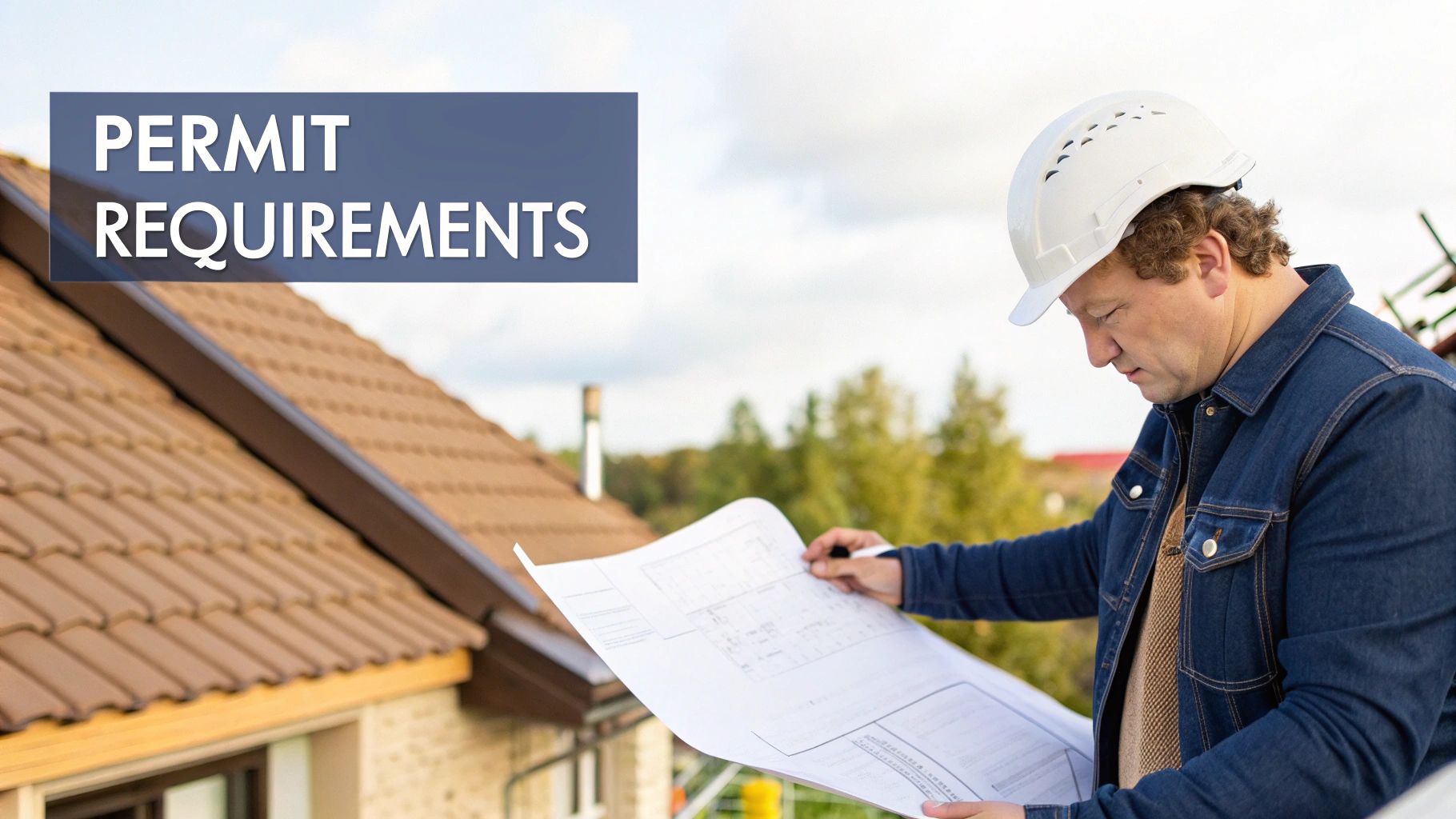
Alright, so your roof has passed the physical exam—it’s strong, made of the right stuff, and gets plenty of sun. Now, it's time to tackle the paperwork. This is where things can feel a bit daunting, but it's a crucial part of the process.
Installing a solar system isn't just a home improvement project; it's an electrical upgrade that ties directly into the public power grid. Because of that, there's a whole layer of solar panel roof requirements involving codes, permits, and inspections. This isn't just red tape—it’s all about making sure every installation is safe for you, your property, and the utility workers who keep the lights on for everyone.
This is exactly why partnering with a seasoned installer is a game-changer. They live and breathe this stuff and handle all the bureaucratic heavy lifting for you.
Understanding Building and Fire Safety Codes
The first set of rules you'll encounter are local building codes. These regulations cover the nuts and bolts of the physical installation, like how the panels are anchored to your roof and ensuring they can handle the wind and snow loads common in your area.
A huge piece of this puzzle is fire safety. Local authorities have put a lot of focus here, and for good reason. Fire codes mandate specific setbacks, which are basically clear, empty pathways around your solar panels. These zones are non-negotiable and give firefighters the room they need to work safely in an emergency.
- Ridge Access: Firefighters need a clear path along the peak of your roof to ventilate a house if there's a fire. This usually means leaving 18 to 36 inches of open space on each side of the ridge.
- Perimeter Pathways: You'll also need similar clearances along the edges of the roof so first responders have a safe walkway.
Think of these setbacks as safety lanes. They ensure your solar array doesn't turn into a dangerous obstacle when every second counts.
Adhering to these safety setbacks is non-negotiable. An improperly placed array not only fails inspection but can also create serious hazards, potentially invalidating your homeowner's insurance if something goes wrong.
The Permit Process and Electrical Standards
Before a single panel gets installed, your solar professional will submit a detailed set of plans to your local city or county office to get the right permits. This blueprint outlines every component of your system, and we dive deeper into this in our guide on https://radiantenergysolar.com/solar-panel-permit-requirements/.
These plans must prove the system complies with the National Electrical Code (NEC), which is the gold standard for electrical safety across the country.
A few key electrical rules include:
- Conexión a tierra adecuada: This is essential to prevent the risk of electric shock.
- Rapid Shutdown: A critical safety feature that lets firefighters quickly de-energize the panels on the roof, protecting them from live electrical currents.
- Correct Wiring and Fusing: All wiring must be sized correctly to handle the system’s electrical load without overheating, preventing a fire hazard.
Some regions are even making solar a standard part of new construction. Take California's Title 24, for example. Since 2020, this trailblazing code has required most new homes in the state to be built with a solar PV system right from the start. It’s a powerful move that, along with financial programs like renewable energy grants, is weaving solar power directly into the fabric of modern homebuilding.
Common Questions About Solar Roof Requirements
Even when you've done your homework on roof structures, materials, and local codes, real-world questions always pop up. This last section is all about tackling those common "what-if" scenarios that homeowners run into when they get serious about going solar.
Think of this as the practical FAQ that bridges the gap between planning and installation. We'll walk through everything from inspection snags and insurance updates to the nuances of older homes and tax credits, giving you the confidence to move forward.
What Happens If My Roof Fails Its Inspection?
Finding out your roof isn't quite ready for solar might feel like a major roadblock, but it's actually an essential safety measure. If an inspector finds structural weaknesses or determines your roofing material is past its prime, the project simply gets paused. This isn't a rejection, just a "not yet."
Your solar installer will give you a detailed report explaining exactly what needs to be addressed. The fix could be as straightforward as reinforcing a few rafters, or it might mean a full roof replacement is in order. This step ensures all solar panel roof requirements for safety are locked in before a single piece of equipment goes up.
Can I Install Solar Panels On An Older Home?
Absolutely. Putting solar on an older home happens all the time, but it does call for some extra care. The structural check-up becomes even more critical here. An engineer will need to verify that the home's framing, which could be decades old, can safely handle the added weight of a modern solar array.
Another thing to consider is whether your home is in a historic district. If so, you might run into aesthetic rules from a local preservation board. These guidelines could limit where panels can be placed to keep them from being too visible from the street. It's always smart to check in with your local planning department early on.
"For older homes, the structural and historical review process isn't a barrier; it's a bridge. It ensures that a modern energy system can be safely and respectfully integrated with the home's unique character and history."
This careful approach protects the integrity of your home while letting you reap the benefits of clean energy. It's all about blending the best of the past with the technology of the future.
How Will Solar Panels Affect My Homeowners Insurance?
Solar panels are considered a permanent upgrade to your home, just like a new kitchen or a finished basement. Because of this, they are almost always covered under a standard homeowners insurance policy.
Once the installation is done, you'll need to give your insurance provider a heads-up. Since the panels add significant value to your property, your home's total replacement cost will go up. This might cause a slight increase in your annual premium, but it’s crucial for protecting your investment against things like storms, fire, or other covered disasters. Be sure to chat with your insurance agent about the specifics before the work begins.
Can I Include My Roof Replacement In The Federal Solar Tax Credit?
This is a fantastic question, and the answer has some nuance. For the most part, the full cost of a standard roof replacement doesn't qualify for the federal solar tax credit. That credit is specifically meant to offset the cost of the solar equipment itself.
However, there can be some wiggle room. If certain structural upgrades are deemed absolutely necessary for the solar installation to happen safely, a portion of those specific costs might be eligible. The rules can be tricky and are subject to change, so it's vital to talk to a qualified tax professional. They can give you the most current advice on what you can legally claim under IRS regulations, making sure you get every penny you're entitled to.
Ready to see if your roof meets the requirements for a solar installation? The team at Energía radiante offers expert assessments and high-quality solar solutions designed for your home. We handle every detail, from structural checks to permitting, to ensure a safe and efficient system that lasts for decades. Start your journey to energy independence with a free consultation today!


